
CBK Govornor,Dr.Kamau Thugge
The Monetary Policy Committee (MPC) met on February 6, 2024, against a backdrop of an improved outlook for global growth and inflation, moderating international oil prices, and heightened geopolitical tensions particularly in the Middle East. The MPC reviewed the
outcomes of its previous decisions and measures implemented to mitigate the adverse economic impact and financial disruptions.
• Global growth is estimated at 3.1 percent in 2023 and is projected at 3.1 percent and 3.2 percent in 2024 and 2025 respectively.
The growth outlook for 2024 has been revised upwards, reflecting stronger-than-expected growth in the United States, continued strengthening of the Chinese economy, and strong growth in several large emerging market and developing economies.
However, the main risks to the global growth outlook relate to the continuing effects of tight monetary policy, the withdrawal of fiscal support in advanced
economies, and increased uncertainties arising from the escalation of geopolitical tensions particularly the Israel-Palestinian conflict.
Headline inflation has continued to decline across most economies due to tight monetary policy, and lower commodity prices particularly of oil and food.

• Kenya’s overall inflation increased to 6.9 percent in January 2024 from 6.6 percent in December 2023, and remained sticky in the upper bound of the Government’s target range.Food inflation increased to 7.9 percent in January 2024 from 7.7 percent in December 2023,largely reflecting higher prices of a few non-vegetable items, following reduced supply partly attributed to seasonal factors.
Fuel inflation rose to 14.3 percent in January 2024 from 13.7 percent in December 2023, largely due to higher electricity tariffs.
Non-food non-fuel (NFNF) inflation increased to 3.6 percent in January 2024 from 3.4 percent in December 2023, partly reflecting seasonal increases in education sector-related costs.
The risks to inflation remain elevated in the near term, reflecting the impact of second-round effects of the rise in fuel inflation, and pass-through effects of exchange rate depreciation.
• The Survey of the Agriculture Sector conducted ahead of the MPC Meeting revealed that respondents expected inflation to increase in the next three months, on account of high import costs, partly due to the depreciation of the exchange rate.
• The GDP data for the third quarter of 2023 shows continued strong performance of the Kenyan economy, with real GDP growing by 5.9 percent compared to 4.3 percent in a similar quarter of 2022.
This performance reflects the strong rebound in the performance of agriculture, and resilient services sector supported by robust activity in accommodation and food services, financial and insurance, information and communication, real estate and wholesale and trade.
Leading indicators of economic activity point to continued strong performance in the fourth quarter of 2023. As a result, real GDP growth is estimated at 5.6 percent in 2023 from 4.8 percent in 2022.
The economy is expected to remain strong in 2024, supported by the resilient services sector, the improved performance in agriculture, implementation of measures to boost economic activity in priority sectors by the Government, and the improved global growth outlook which is expected to benefit exports.

• The CEOs and the Market Perceptions Surveys, which were conducted ahead of the MPC meeting, revealed improved optimism about business activity and economic growth prospects for the next 12 months.
Respondents attributed the optimism to improved performance of agriculture, easing global inflation, a resilient private sector, and focus by the Government on key sectors including agriculture, MSMEs, health, housing, and digital economy.
Nonetheless, respondents expressed concerns about weakened consumer demand,weakening of the Kenya shilling, and high interest rates.
• The current account deficit is estimated at 3.9 percent of GDP in 2023, down from 5.0 percent in 2022, and is projected at 4.0 percent of GDP in 2024, reflecting the expected recovery in imports, resilient remittances, and expected rebound in agricultural exports.
Goods exports declined by 2.2 percent in 2023 compared to an increase of 9.3 percent in 2022.
 The decline in exports in 2023 was across several categories, except food, chemicals and manufactured goods exports which increased by 0.8 percent, 2.8 percent, and 11.3 percent respectively.
The decline in exports in 2023 was across several categories, except food, chemicals and manufactured goods exports which increased by 0.8 percent, 2.8 percent, and 11.3 percent respectively.
The increase in manufactured exports receipts reflect strong regional demand. Imports declined by 10.6 percent in 2023 compared to a growth of 7.3 percent in 2022, reflecting lower imports across all categories, except food and crude materials.
Tourist arrivals improved by 30.7 percent in 2023 compared to 2022, and were 19.3 percent higher in December 2023 compared to December 2022.Remittances increased by 4.0 percent to USD 4,190 million in 2023 from USD 4,028 million in 2022.
• The CBK foreign exchange reserves, which currently stand at USD 7,101 million (3.8 months of import cover), continue to provide adequate cover and a buffer against any short term shocks in the foreign exchange market.
The banking sector remains stable and resilient, with strong liquidity and capital adequacy ratios.
The ratio of gross non-performing loans (NPLs) to gross loans stood at 14.8 percent in December 2023 compared to 15.3 percent in October 2023.
Decreases in NPLs were noted in the energy and water, manufacturing, agriculture, building and construction and transport and communication sectors.
Banks have continued to make adequate provisions for the NPLs.
• Growth in commercial bank lending to the private sector stood at 13.9 percent in December 2023 compared to 13.2 percent in November.
Strong credit growth was observed in the following sectors:manufacturing (20.9 percent), transport and communication (20.8
percent), trade (13.1 percent), and consumer durables (9.9 percent). The number of loan applications and approvals remained resilient, reflecting sustained demand particularly for working capital requirements.
• The Committee noted the ongoing implementation of the FY2023/24 Government Budget, which continues to reinforce fiscal consolidation.
The MPC noted that overall inflation has remained sticky in the upper bound of the target range. The Committee further observed that all key components of inflation—fuel, food, and NFNF— had increased in January.
In addition, the MPC noted the continued, albeit reduced, pressures on the exchange rate and therefore concluded that further action was needed to stabilise prices.
The proposed action will ensure that inflationary expectations remain anchored, while setting inflation on a firm downward path towards the 5.0 percent mid-point of the target range, as well as addressing residual pressures on the exchange rate. The MPC therefore decided to raise the Central Bank Rate (CBR) from 12.50 percent to 13.00 percent.
The MPC will closely monitor the impact of the policy measures as well as developments in the global and domestic economy and stands ready to take further action as necessary in line with its mandate.
The Committee will meet again in April 2024.














